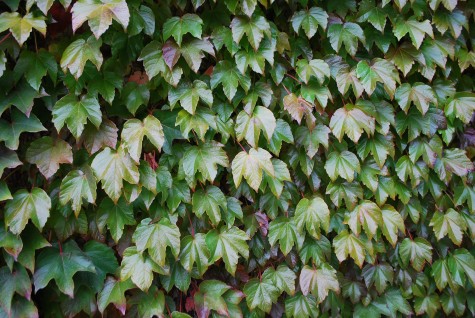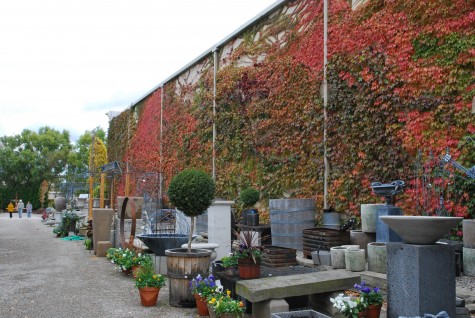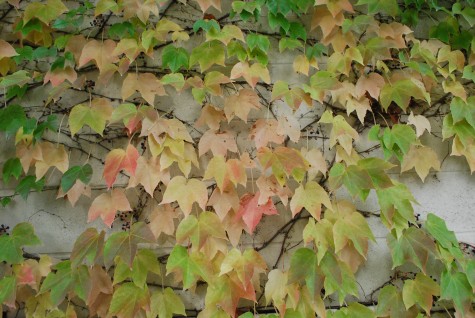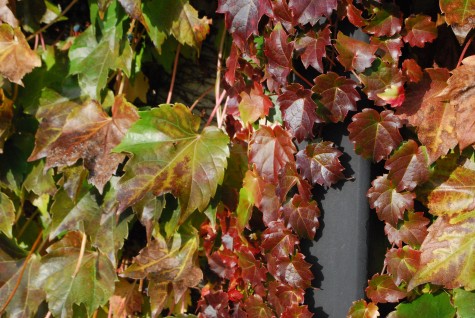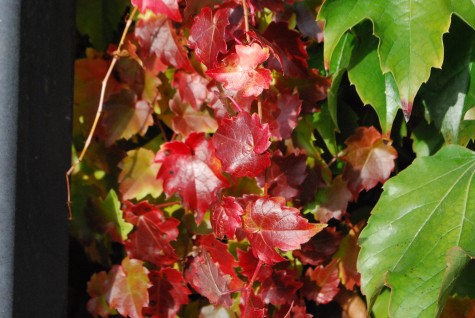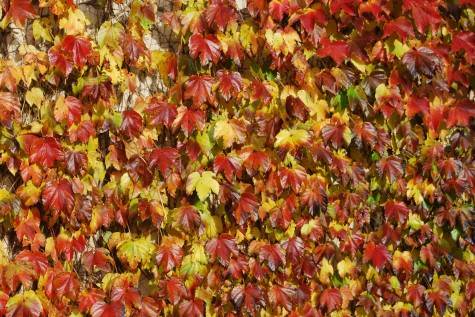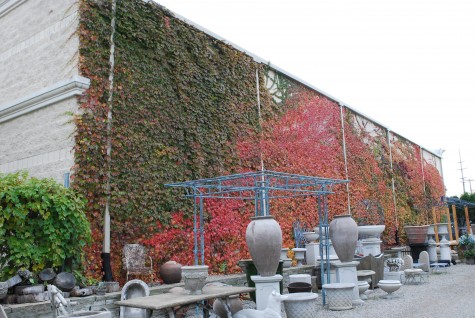At A Glance: Boston Ivy
Coloring Up
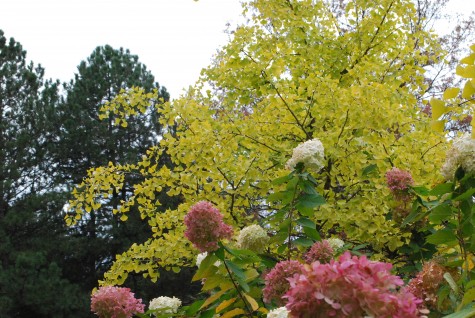 Ideal conditions for great fall color involve a season with decent soil moisture, warm days, and temps at 45 degrees or below at night. Ideal conditions- rare. Abruptly early freezing can interrupt the process by which leaves slowly stop producing chlorophyll; rather than a display in technicolor, we get a limited range of mud-brown and mud grey. This year, it is more than startling that we have not yet had a hard frost; it has been years since Halloween came and went before a killing frost. The night temperatures for the next 10 days look like they will hover in the low forties. We seem to be headed for great color. What is coloring up? Gingko leaves turn a gorgeous citron yellow in the fall; that color matures to a brilliantly clear golden yellow. But a gingko’s main claim to fall fame is about the drop. They drop most every leaf on the same day. Should you happen to be available that day, that drop is a happening.
Ideal conditions for great fall color involve a season with decent soil moisture, warm days, and temps at 45 degrees or below at night. Ideal conditions- rare. Abruptly early freezing can interrupt the process by which leaves slowly stop producing chlorophyll; rather than a display in technicolor, we get a limited range of mud-brown and mud grey. This year, it is more than startling that we have not yet had a hard frost; it has been years since Halloween came and went before a killing frost. The night temperatures for the next 10 days look like they will hover in the low forties. We seem to be headed for great color. What is coloring up? Gingko leaves turn a gorgeous citron yellow in the fall; that color matures to a brilliantly clear golden yellow. But a gingko’s main claim to fall fame is about the drop. They drop most every leaf on the same day. Should you happen to be available that day, that drop is a happening.
 Red maples are aptly named for the intense red color of their fall leaves-but they can disappoint in a dry year. Should that red color be important to you, chose a named cultivar of acer rubrum especially bred for great fall color- like October Glory or Red Sunset. Maple leaves are large, and grow parallel to the ground. This makes the shade they cast particularly dense. But in the fall, the leaves are translucent; light shines through them. This brings that red fall color to life in a spectacular way.
Red maples are aptly named for the intense red color of their fall leaves-but they can disappoint in a dry year. Should that red color be important to you, chose a named cultivar of acer rubrum especially bred for great fall color- like October Glory or Red Sunset. Maple leaves are large, and grow parallel to the ground. This makes the shade they cast particularly dense. But in the fall, the leaves are translucent; light shines through them. This brings that red fall color to life in a spectacular way.
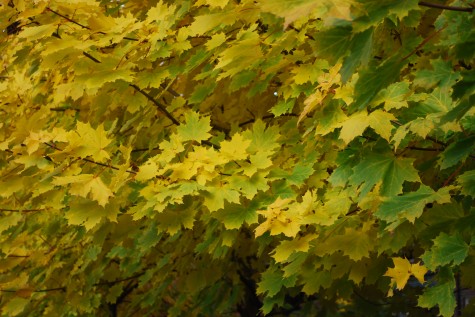 My Princeton Gold maples have an intensely gold fall color. The transition from green to yellow can take weeks. I have never had the inclination to dry flowers in a flower press, but I love pressing fall leaves-in every stage. Searching for my favorite fall leaf is not so different from shelling on a beach, or cutting the best garden flowers for the dinner table. Any gardener understands nature is a teacher, a resource that should be respected and protected- and a source from which to draw a good life.
My Princeton Gold maples have an intensely gold fall color. The transition from green to yellow can take weeks. I have never had the inclination to dry flowers in a flower press, but I love pressing fall leaves-in every stage. Searching for my favorite fall leaf is not so different from shelling on a beach, or cutting the best garden flowers for the dinner table. Any gardener understands nature is a teacher, a resource that should be respected and protected- and a source from which to draw a good life.
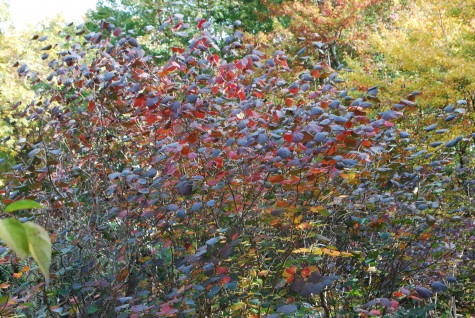 Disanthus Cercidifolius is a rare tree in my zone; native to China and Japan, they thrive in the Pacific northwest. This particular tree I saw just a week ago for the first time at Landscape Supply in Taylor. Wow. Related to witch hazel, this small growing tree has large heart-shaped leaves. However this tree comes into its own in the fall. Leaves turning purple, gold, orange-and finally red; Disanthus wrote the book on fall fireworks. Thriving in uniformly moist and acid soil not unlike what makes rhododendron happy-who would not have one if they could?
Disanthus Cercidifolius is a rare tree in my zone; native to China and Japan, they thrive in the Pacific northwest. This particular tree I saw just a week ago for the first time at Landscape Supply in Taylor. Wow. Related to witch hazel, this small growing tree has large heart-shaped leaves. However this tree comes into its own in the fall. Leaves turning purple, gold, orange-and finally red; Disanthus wrote the book on fall fireworks. Thriving in uniformly moist and acid soil not unlike what makes rhododendron happy-who would not have one if they could?
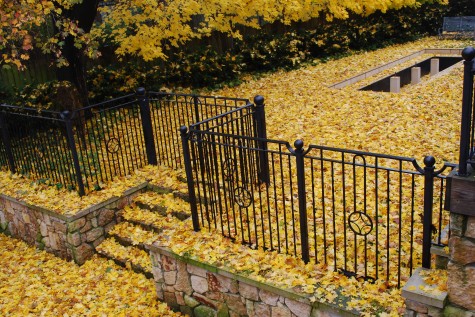 Unlike the regal Disanthus, my Norway maple is distinguished only by its age and size. This means that the sheer volume of fall leaves that will blanket my entire yard in yellow is newsworthy. This day-before I get to scooping them up-is a glorious day. I was lucky to get this picture before the Corgis got into the yard; they relish making a little ruckus running through these leaves.
Unlike the regal Disanthus, my Norway maple is distinguished only by its age and size. This means that the sheer volume of fall leaves that will blanket my entire yard in yellow is newsworthy. This day-before I get to scooping them up-is a glorious day. I was lucky to get this picture before the Corgis got into the yard; they relish making a little ruckus running through these leaves.
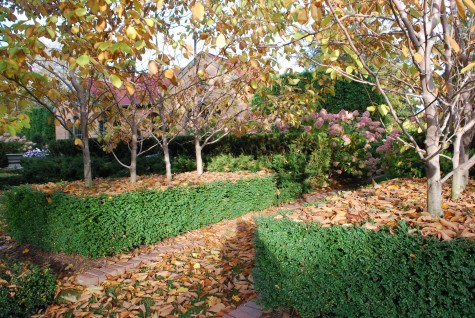 Magnolias have lusciously large leaves-but their fall color I would charitably describe as “tan”. The beauty of the fall leaf drop has everything to do with the boxwood tables underneath them. These drab fallen leaves are a kind of late season frosting on a series of shapes. The spring drop of their yellow petals is followed by a fall drop of their dehiscing leaves. There is a pattern, a order of events-the season changing. The fall color on the magnolias-not anything to celebrate.
Magnolias have lusciously large leaves-but their fall color I would charitably describe as “tan”. The beauty of the fall leaf drop has everything to do with the boxwood tables underneath them. These drab fallen leaves are a kind of late season frosting on a series of shapes. The spring drop of their yellow petals is followed by a fall drop of their dehiscing leaves. There is a pattern, a order of events-the season changing. The fall color on the magnolias-not anything to celebrate.
 The body of leaves that fall on the properties we maintain-we collect them all. We compost them. Steve organizes the dispensation and decomposition of every scrap of organic matter we collect. We have at least 7 giant piles going as I speak-all of them are at different stages in the cooking process. Every leaf dropped from my giant Norway maple will be composted, and be returned to the soil.
The body of leaves that fall on the properties we maintain-we collect them all. We compost them. Steve organizes the dispensation and decomposition of every scrap of organic matter we collect. We have at least 7 giant piles going as I speak-all of them are at different stages in the cooking process. Every leaf dropped from my giant Norway maple will be composted, and be returned to the soil.
 My Nicotiana Mutabilis is still thriving-it shrugs off the October cold. Its giant flat leaves are as green as my evergreens; this plant has no plan to shut down anytime soon. Each elongated leaf is still producing chlorophyll for all it is worth. Should you be looking for a plant that starts out strong, stays strong, and finishes very strong-consider this nicotiana.
My Nicotiana Mutabilis is still thriving-it shrugs off the October cold. Its giant flat leaves are as green as my evergreens; this plant has no plan to shut down anytime soon. Each elongated leaf is still producing chlorophyll for all it is worth. Should you be looking for a plant that starts out strong, stays strong, and finishes very strong-consider this nicotiana.
In the fall, the work is leavened with delight.

I have substantial walls enclosing the Detroit Garden Works property; those walls were in place in 1996. Many years ago, I planted Boston ivy on all of these walls. Parthenocissus Tricuspidata Vetcheii. Those walls today are uniformly and solidly and beautifully covered with the leaves of this vine. Those giant 3 lobed leaves are turning color rapidly-every leaf is different. Harmonic–the fall color on the Boston Ivy. In the fall, many of my thoughts revolve around the look of the leaves.
In The Pink
By late October, many garden plants have that foundering, fish out of water look. You know what I mean. My butterburrs are moments from total collapse. The hostas have that translucent sickly yellow color which precedes the frost turning them to mush. But some things look great yet-my Carefree Beauty roses look strikingly fresh. The foliage is lush and healthy. The pink flowers have an intense cerise pink cast from the cold nights. Though a hard frost will finish them off, they are beautiful right now. It is a rare year that we do not have a hard frost before Halloween. Our coldest night yet has been 40, but I doubt this will hold much longer. I appreciate so much what the garden has to offer right now; the dormant season is closer than any northern gardener is willing to admit.
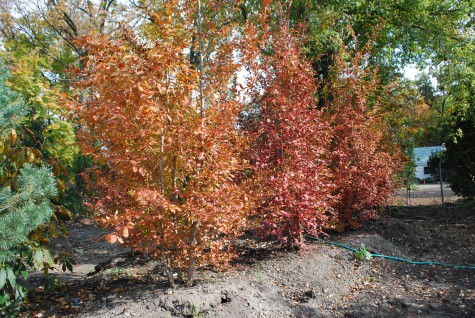 I was fortunate enough to get a tour of Landscape Supply Inc recently from owner Steve Alford. He has made a life’s work of making rare, unusual and specimen plant material available to the trade. I could not tell that this tree was a Stewartia-the tall thin shape is so unusual for this tree. But what I admired the most was that pink-orange fall color-sensational. I understand why many gardeners in my area are so keen for the fall season. At no other time of year is there so much color in the landscape. As few trees are purchased in fall color, it’s worthwhile to consider that fall color when choosing or placing a tree. Landscape design requires lots of thought times 4-the four seasons.
I was fortunate enough to get a tour of Landscape Supply Inc recently from owner Steve Alford. He has made a life’s work of making rare, unusual and specimen plant material available to the trade. I could not tell that this tree was a Stewartia-the tall thin shape is so unusual for this tree. But what I admired the most was that pink-orange fall color-sensational. I understand why many gardeners in my area are so keen for the fall season. At no other time of year is there so much color in the landscape. As few trees are purchased in fall color, it’s worthwhile to consider that fall color when choosing or placing a tree. Landscape design requires lots of thought times 4-the four seasons.
 Petunias shake off the cold and keep right on blooming. This plant has been awash in color since the first of June-5 months. I water much less now, and have really quit looking after them. You would never know this, to look at them. It is an entirely different look from the summer, to see them in the foreground of the kousa dogwood in fall color. If your annuals seem to peter out by labor day, you might want to look into seeing what you could do differently to keep them producing throughout the fall.
Petunias shake off the cold and keep right on blooming. This plant has been awash in color since the first of June-5 months. I water much less now, and have really quit looking after them. You would never know this, to look at them. It is an entirely different look from the summer, to see them in the foreground of the kousa dogwood in fall color. If your annuals seem to peter out by labor day, you might want to look into seeing what you could do differently to keep them producing throughout the fall.
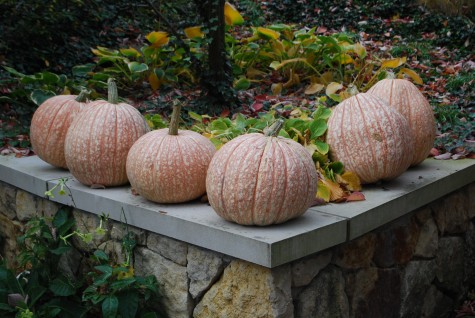 I do love Halloween; Buck and I must have hundreds of kids and families who come by that night. This variety, curiously named “One Too Many”, I will carve, and set in my pots Halloween night. The white pumpkins have orange netting that has a decidedly pink cast. I may set each one up on a circle of all white pumpkins. Or maybe the traditional orange; making decisions like this is the fun part of gardening.
I do love Halloween; Buck and I must have hundreds of kids and families who come by that night. This variety, curiously named “One Too Many”, I will carve, and set in my pots Halloween night. The white pumpkins have orange netting that has a decidedly pink cast. I may set each one up on a circle of all white pumpkins. Or maybe the traditional orange; making decisions like this is the fun part of gardening.
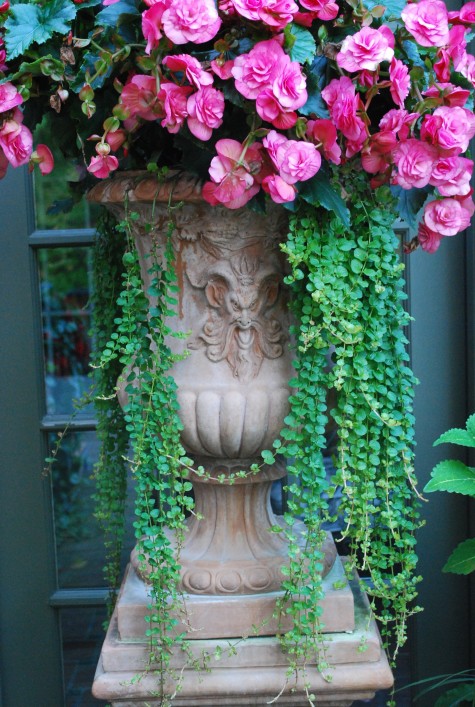 My Solenia rose begonias are in a very protected spot on my deck-they have been spared with blustery winds and driving rain. They are an outstanding strain of large flowered begonias. They have been covered in flowers for months, and only ask that I be careful not to overwater. They are geniunely in the pink right now.
My Solenia rose begonias are in a very protected spot on my deck-they have been spared with blustery winds and driving rain. They are an outstanding strain of large flowered begonias. They have been covered in flowers for months, and only ask that I be careful not to overwater. They are geniunely in the pink right now.

Limelight hydrangeas put on a spectacular fall display. In varying shades of cream-white, green, pink, and rose pink, they dry readily in this stage. Kept out of direct light indoors, they keep their color as long as you want to look at them. One bouquet I particularly fancy I have had almost 4 years now.

There are lots of plants that endure or thrive in the fall. The toad lilies are blooming now, as are the anemones and boltonia. My grasses are beautiful. The boston ivy is beginning to color up. My Caliente pink geraniums, so highly recommended by Alan Armitage, look as good today as they did every day of the past 5 months. The trees are turning. The early hours of the day make for skies more likely to be pink than blue. It is an exciting time of year.
A Pedestrian Bridge
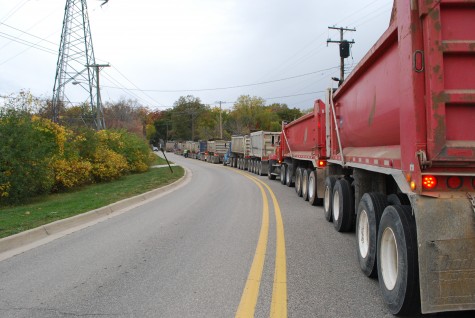 This was the scene on Pontiac Drive at 7am yesterday. Tractor trailer after tractor trailer-every one filled with dirt. Down the street from us, a bridge is under construction. The bridge will cross over 6 lanes of Telegraph road. 2 spans, totalling 315 feet. The Clinton River trail system, built primarily over a section of railroad which was closed in 1998, is a pedestrian path friendly to bike riders, runners and walking folk, stretching from from South Lyon to Rochester. Current users of the trail have to detour around Telegraph some 5 miles before they are able to hook up to it again on the other side. The bridge will link the Sylvan Lake portion of the trail to the Pontiac portion.
This was the scene on Pontiac Drive at 7am yesterday. Tractor trailer after tractor trailer-every one filled with dirt. Down the street from us, a bridge is under construction. The bridge will cross over 6 lanes of Telegraph road. 2 spans, totalling 315 feet. The Clinton River trail system, built primarily over a section of railroad which was closed in 1998, is a pedestrian path friendly to bike riders, runners and walking folk, stretching from from South Lyon to Rochester. Current users of the trail have to detour around Telegraph some 5 miles before they are able to hook up to it again on the other side. The bridge will link the Sylvan Lake portion of the trail to the Pontiac portion.

Building the bridge will cost something over 2 million dollars; quite a project. We have been privy to the pounding and trucking for weeks now. Needless to say, traffic on this sleepy street has been congested. I was mesmerized by the sight of all of those trucks. There s something about earth work that fascinates me.
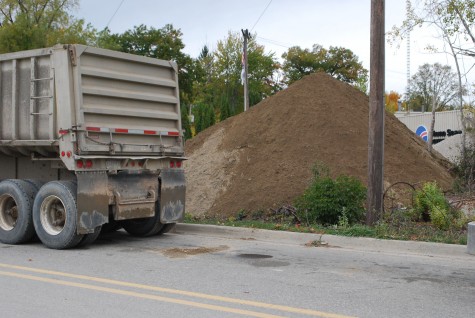 The project is at a stage where they need soil-and lots of it. I had to ask, and was told-each truck hauled in 44 yards of dirt. By my estimation, close to 900 yards of soil arrived in a two hour period yesterday morning. You can tell from the photo above the dirt was very sandy. I have no idea how it is being used-the bridge approach is off limits.
The project is at a stage where they need soil-and lots of it. I had to ask, and was told-each truck hauled in 44 yards of dirt. By my estimation, close to 900 yards of soil arrived in a two hour period yesterday morning. You can tell from the photo above the dirt was very sandy. I have no idea how it is being used-the bridge approach is off limits.
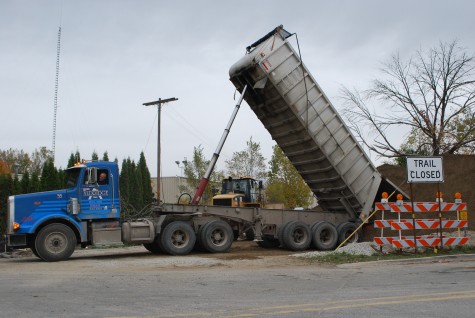 It took about 10 minutes for each trucker to dump one load, detach the trailer, dump the next, and hook the trailer back up. All the while, another 10 trucks were waiting in line. One of the drivers told me that once he fires his diesel powered truck up in the morning, it stays running all day. Apparently it is very hard on the engine to turn them on and off.
It took about 10 minutes for each trucker to dump one load, detach the trailer, dump the next, and hook the trailer back up. All the while, another 10 trucks were waiting in line. One of the drivers told me that once he fires his diesel powered truck up in the morning, it stays running all day. Apparently it is very hard on the engine to turn them on and off.
 The wheels on this bull dozer are taller than I am. The operator ran loads of dirt from the street down to the Telegraph side of the trail all day long. When I left work at 6pm, the dozer was still running back and forth.
The wheels on this bull dozer are taller than I am. The operator ran loads of dirt from the street down to the Telegraph side of the trail all day long. When I left work at 6pm, the dozer was still running back and forth.
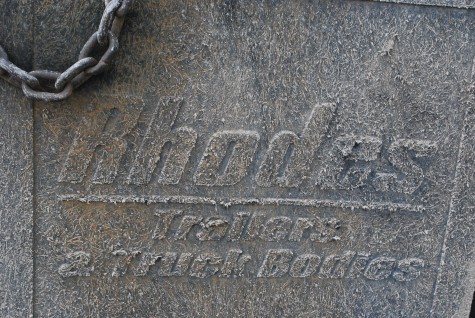 I like everything assciated with the landscape, and that includes the trucks that makes the work possible. They brought my espaliers to me, under refrigeration, from the west coast. They haul soil, plants people and machines for me. They deliver the many pallets of soil mix that we have formulated for our container plantings. Every container that comes from Europe is trucked to the shop for unloading.
I like everything assciated with the landscape, and that includes the trucks that makes the work possible. They brought my espaliers to me, under refrigeration, from the west coast. They haul soil, plants people and machines for me. They deliver the many pallets of soil mix that we have formulated for our container plantings. Every container that comes from Europe is trucked to the shop for unloading.
 Each one of these trucks has 44 tires. I cannot imagine the maintenance associated with a vehicle of this size. No doubt this company has a full time mechanic on staff. I have gardened in places where vehicles were not permitted. Even the most simple job took a lot of time. This in no small part accounts for my great admiration for people who do their own landscaping-and their own trucking.
Each one of these trucks has 44 tires. I cannot imagine the maintenance associated with a vehicle of this size. No doubt this company has a full time mechanic on staff. I have gardened in places where vehicles were not permitted. Even the most simple job took a lot of time. This in no small part accounts for my great admiration for people who do their own landscaping-and their own trucking.

I have no idea how long it will be before bikers and walkers can take the bridge over Telegraph, but it seems like it will be a while yet. I doubt I will ever ride a bike over Telegraph, but it has been an interesting experience to observe a bridge being built.
